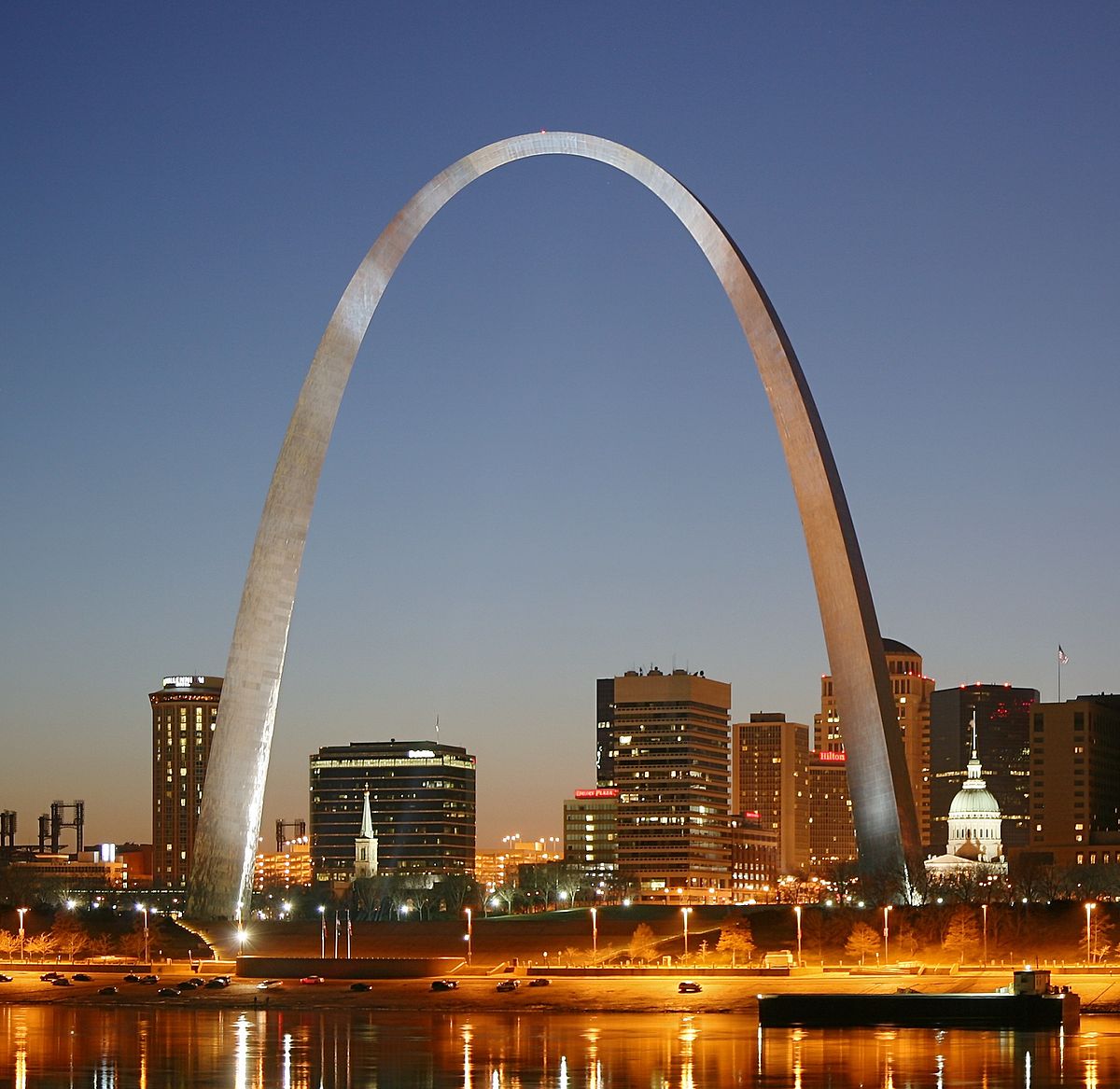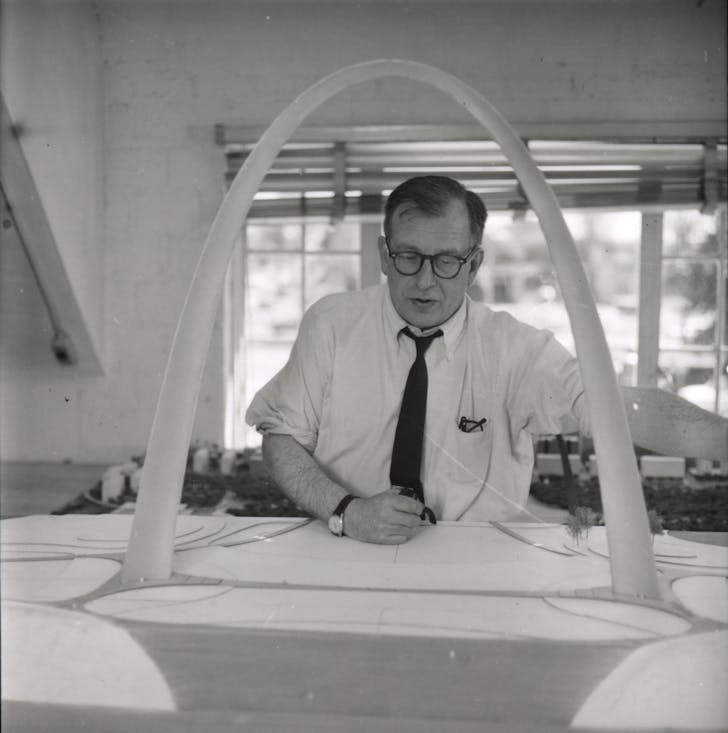The Gateway Arch is a 630-foot (192 m) monument in St. Louis, Missouri, United States. Clad in stainless steel and built in the form of a weighted catenary arch, it is the world's tallest arch, the tallest man-made monument in the Western Hemisphere, and Missouri's tallest accessible building. Built as a monument to the westward expansion of the United States, and officially dedicated to "the American people," the Arch, commonly referred to as "The Gateway to the West" is the centerpiece of Gateway Arch National Park and has become an internationally recognized symbol of St. Louis, as well as a popular tourist destination.

The Arch was designed by Finnish-American architect Eero Saarinen in 1947; construction began on February 12, 1963 and was completed on October 28, 1965 at an overall cost of $13 million (equivalent to $80.6 million in 2018). The monument opened to the public on June 10, 1967. It is located at the site of St. Louis's founding on the west bank of the Mississippi River.
The bidding date, originally December 20, 1961, was postponed to January 22, 1962, to clarify the details of the arch construction. About 50 companies that had requested the construction requirements received bidding invitations. Extending from $11,923,163 to $12,765,078, all four bids exceeded the engineer estimate of $8,067,000. Wirth had a committee led by George Hartzog determine the validity of the bids in light of the government's conditions. Following a meeting with the bidders, the committee affirmed the bids' reasonableness, and Wirth awarded the lowest bidder, MacDonald Construction Co. of St. Louis, the contract for the construction of the arch and the visitor center. On March 14, 1962, he signed the contract and received from Tucker $2.5 million, the city's subsidy for the phase. MacDonald reduced its bid $500,000 to $11,442,418. The Pittsburgh-Des Moines Steel Company served as the subcontractor for the shell of the arch.

Saarinen working with a model of the arch in 1957
In 1959 and 1960, ground was broken, and in 1961, the foundation of the structure was laid. Construction of the arch itself began on February 12, 1963, as the first steel triangle on the south leg was eased into place. These steel triangles, which narrowed as they spiraled to the top, were raised into place by a group of cranes and derricks. The arch was assembled of 142 12-foot-long (3.7 m) prefabricated stainless steel sections. Once in place, each section had its double-walled skin filled with concrete, prestressed with 252 tension bars. In order to keep the partially completed legs steady, a scissors truss was placed between them at 530 feet (160 m), later removed as the derricks were taken down. The whole endeavor was expected to be completed by fall 1964, in observance of St. Louis's bicentennial.

Arch construction in June 1965.
Contractor MacDonald Construction Co. arranged a 30-foot (9.1 m) tower for spectators and provided recorded accounts of the undertaking. In 1963, a million people went to observe the progress, and by 1964, local radio stations began to broadcast when large slabs of steel were to be raised into place. St. Louis Post-Dispatch photographer Art Witman documented the construction for the newspaper's Sunday supplement Pictures, his longest and most noted assignment. He visited the construction site frequently from 1963 to 1967 recording of every stage of progress. With assistant Renyold Ferguson, he crawled along the catwalks with the construction workers up to 190m above the ground. He was the only news photographer on permanent assignment at the construction, with complete access. He primarily worked with slide film, but also used the only Panox camera in St. Louis to create panoramic photographs covering 140 degrees. Witman's pictures of the construction are now housed in the State Historical Society of Missouri.
The first proposal to illuminate the arch at night was announced on May 18, 1966, but the plan never came to fruition. In July 1998, funding for an arch lighting system was approved by St. Louis's Gateway Foundation, which agreed to take responsibility for the cost of the equipment, its installation, and its upkeep.

The arch illuminated in pink in honor of Breast Cancer Awareness Month
In January 1999, MSNBC arranged a temporary lighting system for the arch so the monument could be used as the background for a visit by Pope John Paul II. Since November 2001, the arch has been bathed in white light between 10 p.m. and 1 a.m. via a system of floodlights. Designed by Randy Burkett, it comprises 44 lighting fixtures situated in four pits just below ground level.
In April 1965, three million tourists were expected to visit the arch after completion; 619,763 tourists visited the top of the arch in its first year open. On January 15, 1969, a visitor from Nashville, Tennessee, became the one-millionth person to reach the observation area; the ten-millionth person ascended to the top on August 24, 1979.

Southern entrance to the subterranean visitor center
In 1974, the arch was ranked fourth on a list of "most-visited man-made attraction". The Gateway Arch is one of the most visited tourist attractions in the world with over four million visitors annually, of which around one million travel to the top. The arch was listed as a National Historic Landmark on June 2, 1987, and is also listed on the National Register of Historic Places.
Near the top of the Arch, passengers exit the tram compartment and climb a slight grade to enter the observation area. This arched deck, which is over 65 feet (20 m) long and 7 feet (2.1 m) wide, can hold up to about 160 people, four trams' worth Sixteen windows per side, each measuring 7 by 27 inches (180 mm × 690 mm), offer views up to 30 miles (48 km) to the east across the Mississippi River and southern Illinois with its prominent Mississippian culture mounds at Cahokia Mounds and to the west over the city of St. Louis and St. Louis County beyond.

The Gateway Arch packs a significant symbolic wallop just by standing there. But the Arch has a mission greater than being visually affecting. Its shape and monumental size suggest movement through time and space, and invite inquiry into the complex, fascinating story of our national expansion.
—Robert W. Duffy of the St. Louis Post-Dispatch, October 4, 2003